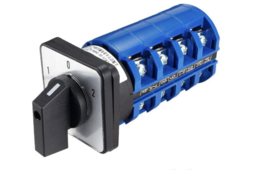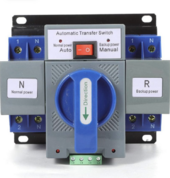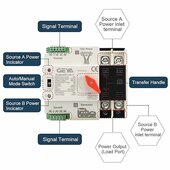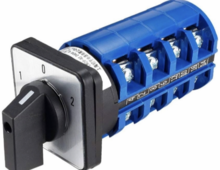You are using an out of date browser. It may not display this or other websites correctly.
You should upgrade or use an alternative browser.
You should upgrade or use an alternative browser.
Automatic Transfer Switch
- Thread starter pabla007
- Start date
OffGridInTheCity
Solar Wizard
You ask why no one is using..... For me, I only use UL/ETL certified ATSs at home and in my trailer and I don't see UL/ETL on the product listing - https://www.geya.net/automatic-transfer-switch-for-pv/ But I agree, it's an interesting looking unit.
I am thinking about it. I have to replace mine as it failed last season.how come no one is using Din Rail Mounted Automatic Transfer Switch Three Phase ATS 2Pole 63A 110V Power Transfer Switch (2P-63A-110V) in RV. I think it id simpler and one.
0truck0
New Member
I think the reason is that for houses, when power goes out you want it to switch by itself, power does go out at times.
In an RV, this is not really a concern. If you have shore power then that is more rare for people with full capacity solar/battery, bc those ppl are set up for boondocking or dry camping for the reason they tend to dry camp.
When on battery then likely there is no other source (a running generator or shore) of power to switch to, manual intervention needed such as cranking a generator If there was shore power then the RV would already be on shore power.
Things that run on DC will switch auto already via the charger/converter or will be running off the battery which could be running off a charger, so no switch needed.
To have an auto switch, so if shore power goes out it switches to the inverter, is just not something people seem to need. I would never ever leave the inverter on and running just to have everything automatically able to switch over to inverter if shore goes out. In such a case I would want to go investigate (something you really cant do at house if power lines are down many miles away).
When setting up camp, or pulling into a camp spot, shore power or no power, then that is easy enough time to manually select the power source. Yes, easy to have an auto switch, but for the price and extra complexity, whats the point? Why would you ask on a solar forum this question?
In an RV, this is not really a concern. If you have shore power then that is more rare for people with full capacity solar/battery, bc those ppl are set up for boondocking or dry camping for the reason they tend to dry camp.
When on battery then likely there is no other source (a running generator or shore) of power to switch to, manual intervention needed such as cranking a generator If there was shore power then the RV would already be on shore power.
Things that run on DC will switch auto already via the charger/converter or will be running off the battery which could be running off a charger, so no switch needed.
To have an auto switch, so if shore power goes out it switches to the inverter, is just not something people seem to need. I would never ever leave the inverter on and running just to have everything automatically able to switch over to inverter if shore goes out. In such a case I would want to go investigate (something you really cant do at house if power lines are down many miles away).
When setting up camp, or pulling into a camp spot, shore power or no power, then that is easy enough time to manually select the power source. Yes, easy to have an auto switch, but for the price and extra complexity, whats the point? Why would you ask on a solar forum this question?
justinm001
Solar Addict
- Joined
- Dec 18, 2022
- Messages
- 1,572
I couldn't imagine not having an auto transfer switch. Luckily Victron has these built in and the Quattro does both gen and shore.I think the reason is that for houses, when power goes out you want it to switch by itself, power does go out at times.
In an RV, this is not really a concern. If you have shore power then that is more rare for people with full capacity solar/battery, bc those ppl are set up for boondocking or dry camping for the reason they tend to dry camp.
When on battery then likely there is no other source (a running generator or shore) of power to switch to, manual intervention needed such as cranking a generator If there was shore power then the RV would already be on shore power.
Things that run on DC will switch auto already via the charger/converter or will be running off the battery which could be running off a charger, so no switch needed.
To have an auto switch, so if shore power goes out it switches to the inverter, is just not something people seem to need. I would never ever leave the inverter on and running just to have everything automatically able to switch over to inverter if shore goes out. In such a case I would want to go investigate (something you really cant do at house if power lines are down many miles away).
When setting up camp, or pulling into a camp spot, shore power or no power, then that is easy enough time to manually select the power source. Yes, easy to have an auto switch, but for the price and extra complexity, whats the point? Why would you ask on a solar forum this question?
Most RVs with generators have auto transfer switches.
for an rv, I people use it for generator back up, so when they start their generator it will switch over and start charging their batteries, I use it myself for the inverter, so when I am boondocking and I want to use a 120V appliance I just turn on my inverter and the transfer switch energises my 120V side of my power distribution so I can use any plug or appliance.I think the reason is that for houses, when power goes out you want it to switch by itself, power does go out at times.
In an RV, this is not really a concern. If you have shore power then that is more rare for people with full capacity solar/battery, bc those ppl are set up for boondocking or dry camping for the reason they tend to dry camp.
When on battery then likely there is no other source (a running generator or shore) of power to switch to, manual intervention needed such as cranking a generator If there was shore power then the RV would already be on shore power.
Things that run on DC will switch auto already via the charger/converter or will be running off the battery which could be running off a charger, so no switch needed.
To have an auto switch, so if shore power goes out it switches to the inverter, is just not something people seem to need. I would never ever leave the inverter on and running just to have everything automatically able to switch over to inverter if shore goes out. In such a case I would want to go investigate (something you really cant do at house if power lines are down many miles away).
When setting up camp, or pulling into a camp spot, shore power or no power, then that is easy enough time to manually select the power source. Yes, easy to have an auto switch, but for the price and extra complexity, whats the point? Why would you ask on a solar forum this question?
0truck0
New Member
sure, that is how it works.
That is why people DO use it, but is not the topic of why people do NOT use it. If you buy a store bought rv with this stuff in it already then you do use it one would assume. Why do people who do not have it not go to the trouble of installing one? or is this all imaginary?
That is why people DO use it, but is not the topic of why people do NOT use it. If you buy a store bought rv with this stuff in it already then you do use it one would assume. Why do people who do not have it not go to the trouble of installing one? or is this all imaginary?
I understand I made a mistake, posting under solar. I have 30 foot rv trailer. I just finished setting 10 kW batteries with victron multi plus inverter since I am doing all the wiring. I figured it would be nice to purchase the little device set up automatic switch. Before I even purchased just wanted to check with you guys and what other people are doing. I will be setting up transfer switch but just wanted to get other peoples opinion. I will be using 30 amp power and the other side will be connected to generator for back up.
OffGridInTheCity
Solar Wizard
For up to 30a @ 120v, I use Go-Power (ETL) ATS in my trailer - https://www.amazon.com/gp/product/B00153EYTO/ref=ppx_yo_dt_b_search_asin_title Pretty easy to install with wago wire connectors
For up to 50a @ 240v/120v split-phase (US) I use Progressive (ETL) at several places in my home - https://www.amazon.com/gp/product/B003VAWNVK/ref=ppx_yo_dt_b_search_asin_titleie=UTF8&psc=1 Has allen wrench terminals on the relays for up to 6 awg wire.
Both are fully automatic - simple operation.
For up to 50a @ 240v/120v split-phase (US) I use Progressive (ETL) at several places in my home - https://www.amazon.com/gp/product/B003VAWNVK/ref=ppx_yo_dt_b_search_asin_titleie=UTF8&psc=1 Has allen wrench terminals on the relays for up to 6 awg wire.
Both are fully automatic - simple operation.
One issue you need to solve is your N-G bond. (Neutral-Ground Bond). This unit doesn’t help.how come no one is using Din Rail Mounted Automatic Transfer Switch Three Phase ATS 2Pole 63A 110V Power Transfer Switch (2P-63A-110V) in RV. I think it id simpler and one.
When on inverter your inverter needs to supply the N-G.
When on generator, the generator needs to supply the N-G bond.
When on Grid, the grid will supply the bond.
You CANNOT have more than one N-G bond at a time (bad things happen if it is needed).
With the transfer switches you purchase they flip both the hot and the neutral at the same time- so it isolates the N-G bond at the generator (disconnected it) from the grid. Then you only have to make sure your inverter is handling the N-G bond correctly. Makes the connection when inverting and breaks it when incoming power is active.
The way I wrote that (above) is using my Victron Multiplus inverter that accepts power from the grid/generator. If you have the transfer switch switch between the inverter & the generator/grid, then the inverter doesn’t need to switch the N-G bond because the transfer switch will isolate it.
It’s all in how you plan it.
The above switch would be difficult to properly implement into a RV.
12VoltInstalls
life passes by too quickly to not live in freedom
…because it doesn’t switch G?the transfer switch will isolate it.
It’s all in how you plan it.
The above switch would be difficult to properly implement into a RV.
That’s what I’m searching for: a cheap ATS for 120/240 split phase that disconnects / isolates the Inverter Source Green/bare/ground when it switches to generator and vise versa.
My ‘life’ runs on 12VDC and 120VAC, while the shop is mostly 120VAC but the generator has 240 split phase. 240 runs the TiG (occasional), the plasma (irregularly often), and the generator makes 25A+ per leg which makes the twins (two Lincoln 120V wirefeeds; 1 MiG setup, the other with fluxcore) behave better.
I could run one of these:

…which will switch all four (disabling half the breaker box when on house inverter/solar) but then it occurred to me that if I used an ATS like this:

…but that switched 4 contacts it would do the same exact thing automatically whenever the generator is fired up.
(Although maybe it does switch G? But erroneously has two N’s instead of 1N and 1G per input?)
Basically that eliminates me needing to unbond the generator so I can still use it remotely without needing to reconnect the N-G bond- and a couple of other potential N/G bonding issues I haven’t finished thinking through yet.
Is anyone aware of a cheap 4-terminal?
The other option I haven’t thought through is common neutral. Be gentle: haven’t thought it through past just typing this, and I haven’t asked the inverter yet if it would like to share. .
Last edited:
12VoltInstalls
life passes by too quickly to not live in freedom
Yes.Wouldn't it be easier to just install a SPST neutral-ground bond switch on the genset?
But not daughters and grandkids -proofed. With the ATS or the rotary switch: if they don’t throw the N-G switch it will still appear to “be working” to laymen.
stienman
Mostly Harmless
- Joined
- Jan 6, 2021
- Messages
- 477
I use one for my house. That way I don't have to worry about grid interconnect - use a growatt 12k off grid inverter, batteries, and solar. It's out in an outbuilding, though, with only one 60A set of wires, and one 20A set of wires going from the house to the outbuilding - otherwise I'd use the inverter's built in transfer switch, which is what I expect most people do.
Instead I have the inverter fed by the 20A from the utility power so I can do arbitrage if desired, and the output goes to a breaker that goes to the 60A lines to the house. At the house I have a 4 pole 100A ATS - one step up from the one you've listed. I used the one you show at first, but it eventually broke, leaving me missing one leg of my split phase. I had a transformer on the house side of the circuit (to balance the legs since too large a discrepancy would trip the older 6k inverter I previously used), so nothing broke, and we didn't even notice the leg had gone except some weirdness when on solar.
The failure of the ATS was weird - mechanical on one pole, the bar that moved and made contact had broken out of its holder, so was no longer making contact - so when I replaced it I used a 100A, and used a four pole - doubling the poles so each leg had two contacts. This not only spreads the load, but it increases the redundancy if another similar mechanical failure occurs.
The only problem with the larger 100A 4 pole ATS, though, is it switches more slowly, so while we had no devices that would reboot with the older two pole ATS, we have at least one TV which is reset during the larger 100A ATS switchover. If I cared I could put a UPS on it, but it's not important. Turning the balancing transformer back on would probably solve this as well, but with the new inverter we don't need it and it does consume power.
Notably, these cheap ATS devices are not UL compliant. I mounted mine in the top of the breaker panel above the main breaker, with utility coming on one side from the old breaker panel, and solar coming in from the right. It mounts on a DIN rail and I have additional 63A DIN breakers on each input to the ATS. It then feeds the main breaker of the new panel. It's inaccessible, though if I desired I could elevate it and provide access to the handle, or add a handle to the panel that attaches to this handle.
One thing about these ATS units, though, is you see the black cover over the switching area - these are vented, and when switching under load they vent live sparks out of the ATS. It was something to behold the first time I saw it, and the few times I let it flip back and forth dozens of times a second it was like a shower of sparks, and the vents started to deform due to the heat. It's what prevented me from cutting a hole in the front panel to allow access to the switch. Ain't nobody got time for live sparks thrown out into the basement. They still get thrown, but now behind the panel, inside the breaker box.
Issues with these:
- Not UL rated.
- They throw sparks out the vent when switched under load.
- There is no hysteresis. If you have them set to automatically switch (this is configured using wires to the solenoid control) you can make them switch back and forth dozens of times a second if you put a heavy load on the output, and the preferred input turns off under that load, then turns back on when the load is removed.
- They don't allow wire to be attached directly, but require a fork or ring terminal
But if you want a cheap ATS, and account for these issues they work well, and since the solenoid is a low current device connecting a wifi or other external controller (and adding hysteresis or other logic) is an easy way to switch heavy loads without using a power-hungry contactor.
Of course, a UL certified 100A or 200A generator ATS would be better in many ways, but they are not cheap, they take more space, and they are not as easily controlled externally without getting even more expensive.
Instead I have the inverter fed by the 20A from the utility power so I can do arbitrage if desired, and the output goes to a breaker that goes to the 60A lines to the house. At the house I have a 4 pole 100A ATS - one step up from the one you've listed. I used the one you show at first, but it eventually broke, leaving me missing one leg of my split phase. I had a transformer on the house side of the circuit (to balance the legs since too large a discrepancy would trip the older 6k inverter I previously used), so nothing broke, and we didn't even notice the leg had gone except some weirdness when on solar.
The failure of the ATS was weird - mechanical on one pole, the bar that moved and made contact had broken out of its holder, so was no longer making contact - so when I replaced it I used a 100A, and used a four pole - doubling the poles so each leg had two contacts. This not only spreads the load, but it increases the redundancy if another similar mechanical failure occurs.
The only problem with the larger 100A 4 pole ATS, though, is it switches more slowly, so while we had no devices that would reboot with the older two pole ATS, we have at least one TV which is reset during the larger 100A ATS switchover. If I cared I could put a UPS on it, but it's not important. Turning the balancing transformer back on would probably solve this as well, but with the new inverter we don't need it and it does consume power.
Notably, these cheap ATS devices are not UL compliant. I mounted mine in the top of the breaker panel above the main breaker, with utility coming on one side from the old breaker panel, and solar coming in from the right. It mounts on a DIN rail and I have additional 63A DIN breakers on each input to the ATS. It then feeds the main breaker of the new panel. It's inaccessible, though if I desired I could elevate it and provide access to the handle, or add a handle to the panel that attaches to this handle.
One thing about these ATS units, though, is you see the black cover over the switching area - these are vented, and when switching under load they vent live sparks out of the ATS. It was something to behold the first time I saw it, and the few times I let it flip back and forth dozens of times a second it was like a shower of sparks, and the vents started to deform due to the heat. It's what prevented me from cutting a hole in the front panel to allow access to the switch. Ain't nobody got time for live sparks thrown out into the basement. They still get thrown, but now behind the panel, inside the breaker box.
Issues with these:
- Not UL rated.
- They throw sparks out the vent when switched under load.
- There is no hysteresis. If you have them set to automatically switch (this is configured using wires to the solenoid control) you can make them switch back and forth dozens of times a second if you put a heavy load on the output, and the preferred input turns off under that load, then turns back on when the load is removed.
- They don't allow wire to be attached directly, but require a fork or ring terminal
But if you want a cheap ATS, and account for these issues they work well, and since the solenoid is a low current device connecting a wifi or other external controller (and adding hysteresis or other logic) is an easy way to switch heavy loads without using a power-hungry contactor.
Of course, a UL certified 100A or 200A generator ATS would be better in many ways, but they are not cheap, they take more space, and they are not as easily controlled externally without getting even more expensive.
12VoltInstalls
life passes by too quickly to not live in freedom
shadowmaker
Solar Addict
Not RV, but I'm using these in my system although 4pole 125A 400V (3-phase AC here). I have two connecting/disconnecting AC coupling to my inverters and one to switch island mode in my main panel in case of outage. Very chinese but with all important CE-marking and seem to work so far. No sparks yet.how come no one is using Din Rail Mounted Automatic Transfer Switch Three Phase ATS 2Pole 63A 110V Power Transfer Switch (2P-63A-110V) in RV. I think it id simpler and one.
12VoltInstalls
life passes by too quickly to not live in freedom
Do you mind sharing a link?I'm using these in my
I’m a curious person.
shadowmaker
Solar Addict
Go to Aliexpress and search "4p 125a ATS" and you get loads to choose from.Do you mind sharing a link?
I’m a curious person.
Similar threads
- Replies
- 2
- Views
- 470
- Replies
- 3
- Views
- 253
- Replies
- 3
- Views
- 125




